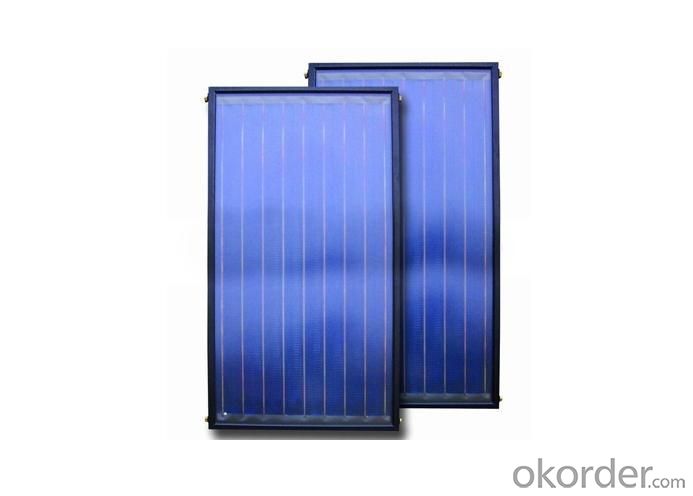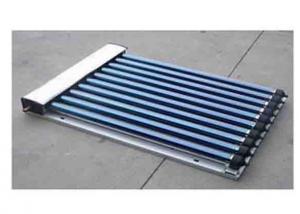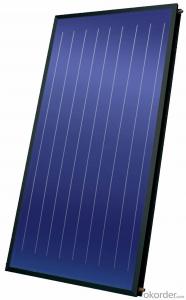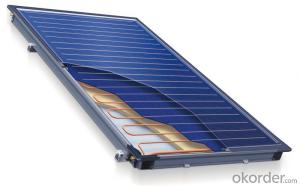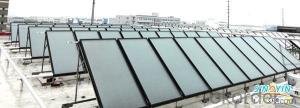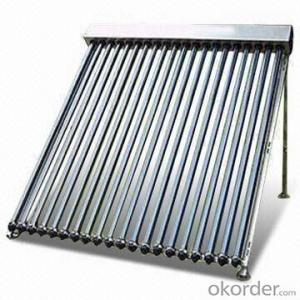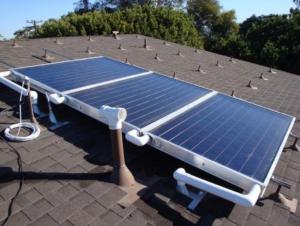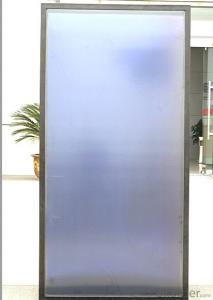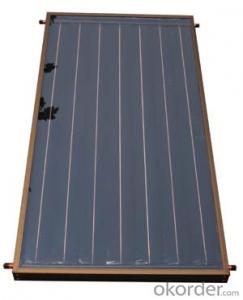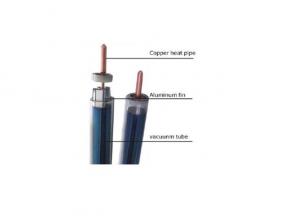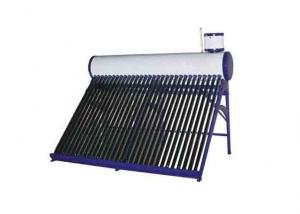Glazed Flat Plate Solar Collector
- Loading Port:
- China Main Port
- Payment Terms:
- TT or LC
- Min Order Qty:
- 1 Piece pc
- Supply Capability:
- 5000 Pieces per Month pc/month
OKorder Service Pledge
OKorder Financial Service
You Might Also Like
flat plate solar collector:
1)high quality
2)the most competitive price
3)best service
Specification of flat plate solar collector:
1)Dimension:2000%*1060*70
2)Gross area: 2 m2
3)Absorb area:1.8 m2
4)Conversion factor:78.5η%
5)Fluit content:2.2L
6)Maxmium operating pressure:1MPA
7)Temperature of operation:35-150 oC
8)Net weighte:32 KG/ PCS
9)Core: all cooper, ultrasonic welding
10)Coating: highly selective titanium coating from Germany
11)Abosorbe material:cooper
12)Header pipe ,material: copper
13)Materila of glass: tempered glass
14)Dimension of glass sheet:1988mm*988mm
15)Material of frame: aluminum alloy
16)Color of frame: champagne/brone-colored/white
17)Insulation : material, high pressure, high density polyrethane foam
18) Thickness of insulation :30mm/40mm/50mm
19)Material and thickness of black sheet:embossed aluminum blacksheet o.3mm
20)Cover sealing material:EPDM+ metal
21)Packing dimension:2020mm*1100*160mm
- Q: Can solar collectors be used for generating electricity on amusement park rides?
- Yes, solar collectors can be used for generating electricity on amusement park rides. Solar collectors, also known as solar panels, are designed to convert sunlight into electricity. They can be installed on the rooftops or other suitable locations of amusement park rides to harness the abundant sunlight available during the day. The generated electricity can then be used to power various components of the ride, such as lights, sound systems, motors, and other electrical equipment. By utilizing solar collectors, amusement park rides can reduce their reliance on traditional power sources, decrease carbon emissions, and contribute to a more sustainable and environmentally friendly operation.
- Q: How do solar collectors impact property values?
- Solar collectors can have a positive impact on property values as they are considered a desirable and sustainable feature. They can add to the overall appeal and attractiveness of a property, potentially increasing its market value. Additionally, solar collectors can reduce energy costs, which can be an attractive selling point for potential buyers and contribute to the overall value of the property.
- Q: Can solar collectors be used to generate hot air?
- Yes, solar collectors can be used to generate hot air. Solar collectors, also known as solar thermal collectors, are designed to capture the sun's heat and convert it into usable thermal energy. This energy can be used for various purposes, including heating air. Solar air heating systems typically consist of a series of collectors that are mounted on a roof or an open area with good sun exposure. These collectors are made up of a dark-colored, heat-absorbing material, usually metal or plastic, which absorbs the sun's radiation. As the collectors absorb the sunlight, they convert it into heat, which is then transferred to air passing through the collector. The heated air can be used in a variety of applications, such as space heating in homes, commercial buildings, or industrial processes. Solar air heating systems can provide a cost-effective and sustainable alternative to traditional heating methods, reducing reliance on fossil fuels and lowering greenhouse gas emissions. It is important to note that while solar collectors can generate hot air, their efficiency and performance depend on factors such as the angle and orientation of the collectors, the amount of sunlight available, and the design and insulation of the system. Proper installation and system sizing are crucial to maximize the effectiveness of solar air heating systems.
- Q: Can solar collectors be used for heating swimming pools in winter?
- Yes, solar collectors can be used for heating swimming pools in winter. Solar collectors are designed to capture and convert sunlight into heat energy, which can then be used to warm the water in swimming pools. However, the efficiency of solar collectors may vary depending on the climate and the amount of sunlight available during winter months. Additional heating methods or pool covers may be necessary to supplement solar heating in colder regions.
- Q: Can solar collectors be used for refrigeration?
- Yes, solar collectors can be used for refrigeration. Solar thermal energy can be harnessed and converted into cooling power using absorption refrigeration systems. These systems use solar collectors to heat a working fluid, which then drives a refrigeration cycle to produce cold temperatures for cooling purposes. This sustainable and efficient technology is especially beneficial in areas with abundant sunlight and high cooling demands.
- Q: Are solar collectors expensive to install?
- Solar collectors can be expensive to install initially, but they can save you money in the long run by reducing your energy bills. The cost of installation depends on various factors such as the size of the system, location, and any additional equipment needed.
- Q: Can solar collectors be used for heating livestock buildings?
- Yes, solar collectors can be used for heating livestock buildings. Solar collectors, such as solar water heaters or solar air heaters, can capture the sun's energy and convert it into heat. This heat can then be utilized to warm up the livestock buildings and create a more comfortable environment for the animals. Solar heating systems are a sustainable and cost-effective solution for heating livestock buildings, reducing reliance on traditional heating methods and minimizing energy costs.
- Q: Can solar collectors be used for heating cathedrals?
- Yes, solar collectors can be used for heating cathedrals. Solar thermal collectors can capture sunlight and convert it into heat energy, which can then be used for heating purposes. This renewable energy source can be an efficient and sustainable option for heating large spaces such as cathedrals.
- Q: Can solar collectors be used for snow melting?
- Yes, solar collectors can be used for snow melting. Solar collectors can generate heat, which can be used to melt snow and ice on surfaces such as driveways, walkways, and roofs. This can help prevent accumulation of snow and improve safety during winter months.
- Q: Can solar collectors be used for heating water for agricultural purposes?
- Yes, solar collectors can be used for heating water for agricultural purposes. Solar water heating systems can efficiently heat water using solar energy, reducing dependence on traditional heating methods and saving energy costs. This heated water can be used for various agricultural purposes such as irrigation, livestock watering, greenhouse heating, and sanitation.
1. Manufacturer Overview
| Location | Zhejiang,China |
| Year Established | 2005 |
| Annual Output Value | US$2.5 Million - US$5 Million |
| Main Markets | North America South America Eastern Europe Southeast Asia Africa Oceania Mid East Eastern Asia Western Europe Central America Northern Europe Southern Europe Domestic Market |
| Company Certifications | ISO9001:2008;ISO14001:2004 |
2. Manufacturer Certificates
| a) Certification Name | |
| Range | |
| Reference | |
| Validity Period |
3. Manufacturer Capability
| a) Trade Capacity | |
| Nearest Port | Shanghai,Hangzhou |
| Export Percentage | 41% - 50% |
| No.of Employees in Trade Department | 6-10 People |
| Language Spoken: | English, Chinese |
| b) Factory Information | |
| Factory Size: | 5,000-10,000 square meters |
| No. of Production Lines | 5 |
| Contract Manufacturing | OEM Service Offered Design Service Offered Buyer Label Offered |
| Product Price Range | Average |
Send your message to us
Glazed Flat Plate Solar Collector
- Loading Port:
- China Main Port
- Payment Terms:
- TT or LC
- Min Order Qty:
- 1 Piece pc
- Supply Capability:
- 5000 Pieces per Month pc/month
OKorder Service Pledge
OKorder Financial Service
Similar products
Hot products
Hot Searches
Related keywords

